The Tesla (Elon Musk) and
New York Times (John Broder) Feud
Understanding the real reasons the Model S ran out of charge
February 23, 2013 (updated 03/12/2013) - Technology Blog Index
duckware.com/tesla
|
Index / Executive Summary
|
|
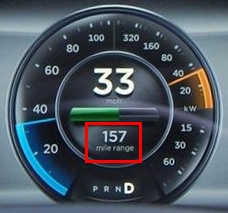
Tesla Model S 'mile range' display
|
Executive Summary: The "mile range" displayed in the Tesla Model S (seen right)
is buggy (especially in cold weather), and outright wrong after battery
conditioning. A New York Times reporter trusted the "mile range"
displayed, and as a direct result, ran out of charge on the road
— and wrote an article stating that. In response, Tesla's CEO Elon Musk,
lashed out at the reporter, calling the article "fake" and a "setup", even
though Tesla's own website range calculator shows significantly reduced range
in the cold (the reporter achieved the range expected). The "mile range" at
one point reduced by 1.22 miles for every mile driven, at another point
(after battery conditioning) displayed a range of 19 miles for a battery
at a 29.5% state of charge
(for context, less than 24 hours earlier, the car displayed a range
of 242 miles for a battery at a 90% state of charge).
When the range displayed by an electric car ignores freezing
cold temperatures, heater usage, etc, resulting in a "mile range" displayed
that is outright wrong, who is to blame — the reporter or the car?
If the Times test drive had been done in 70° F weather (instead of the
freezing cold), the reporter would not have run out of charge. In an
electric car, outside temperature matters.
The fact that the "mile range" displayed by the Model S ignores
temperature and HVAC usage is a significant bug.
- 02/08/13:
 Stalled Out on Tesla s Electric Highway
- John Broder, New York Times
Stalled Out on Tesla s Electric Highway
- John Broder, New York Times
- 02/10/13:
 "Stalled on the E.V. Highway", page AU1, print edition.
"Stalled on the E.V. Highway", page AU1, print edition.
- 02/11/13:
 CNBC interview
- Elon Musk, Tesla (calls article a "setup"
transcript)
CNBC interview
- Elon Musk, Tesla (calls article a "setup"
transcript)
- 02/11/13:
 Times article is fake
- Elon Musk, Twitter
Times article is fake
- Elon Musk, Twitter
- 02/12/13:
 The Charges Are Flying Over a Test of Tesla s Charging Network
- John Broder
The Charges Are Flying Over a Test of Tesla s Charging Network
- John Broder
- 02/13/13:
 A Most Peculiar Test Drive
- Elon Musk (shows data charts)
A Most Peculiar Test Drive
- Elon Musk (shows data charts)
- 02/14/13:
 Conflicting Assertions Over an Electric Car Test Drive
- NYT, Margaret Sullivan
Conflicting Assertions Over an Electric Car Test Drive
- NYT, Margaret Sullivan
- 02/14/13:
 That Tesla Data: What It Says and What It Doesn t
- John Broder
That Tesla Data: What It Says and What It Doesn t
- John Broder
- 02/18/13:
 Problems With Precision and Judgment, but Not Integrity
- NYT, Margaret Sullivan
Problems With Precision and Judgment, but Not Integrity
- NYT, Margaret Sullivan
- 02/19/13:
 A Most Peculiar Test Drive - Follow Up
- Elon Musk (claims victory)
A Most Peculiar Test Drive - Follow Up
- Elon Musk (claims victory)
- 02/20/13:
 Musk impugned reputation of a good man
- NYT, James G. Cobb on Twitter
Musk impugned reputation of a good man
- NYT, James G. Cobb on Twitter
- 02/21/13:
 Views of Sullivan hers, not NYT
- NYT, Margaret Sullivan
Views of Sullivan hers, not NYT
- NYT, Margaret Sullivan
- 02/22/13:
 After a Charging System Test, a Debate Erupts Online
- Feedback / NYT
After a Charging System Test, a Debate Erupts Online
- Feedback / NYT
- 02/24/13:
 NYT Cost Tesla Hundreds of Orders and $100M valuation
- Elon Musk
NYT Cost Tesla Hundreds of Orders and $100M valuation
- Elon Musk
- 02/27/13:
 The New York Times Did Not Reverse Its Opinion
- Jeff Cobb, HybridCars
The New York Times Did Not Reverse Its Opinion
- Jeff Cobb, HybridCars
- 03/05/13:
 Tesla's Elon Musk flames Times review in Geneva
- CNET
Tesla's Elon Musk flames Times review in Geneva
- CNET
- 03/09/13:
 Musk extends feud, calls Times review an "ethics violation"
- Reuters
Musk extends feud, calls Times review an "ethics violation"
- Reuters
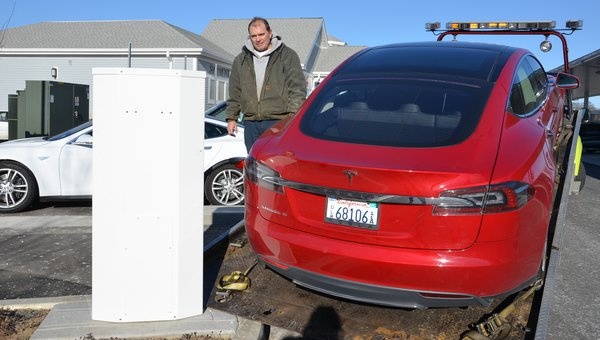
Rick Ibsen (tow truck driver) unloads the Model S from a
flatbed truck at the Supercharger station in Milford, CT.
|
02/08/2013: The New York Times prints a critical review:
The New York Time's John Broder took Tesla's new Model S electric car
up and down the east coast (DC - Boston), and nearly 'ran out of charge' once
-- but did 'run out
of charge' a second time, and had to be towed. The Times ran a photo of the Tesla Model S on a flatbed
truck -- which certainly grabbed a lot of attention, especially when the title of
the article was "Stalled Out on Tesla s Electric Highway".
The title of the article should have been the title of the
graphic
attached to the article, "A Range Estimate Misses the Mark".
02/11/2013: Tesla Response: Tesla's founder and CEO Elon Musk
then goes on TV
(transcript)
and accused Broder of faking the test drive, calling it was a
"setup" and a "fake" because Broder:
- did not charge the car "to the maximum charge"
- "was driving really fast"
- took "an extended detour"

Elon Musk tweeting that NYT article is fake
|

Newark, DE to Milford, CT
|
The wrong question that everyone is asking:
Can the Tesla Model S go the 200 miles between the
Tesla Supercharger at the Travel plaza in Newark, DE and the Tesla
Supercharger in Milford, CT, without running out of charge?
Of course the Teslsa S can go that distance, and many others have demonstrated
that feat both before and after Broder's article.
The right question that should be asked:
Under what circumstances will the Tesla Model S fail to go 200 miles, and why?
So our ultimate goal is to understand the reasons why
a Tesla Model S can run out of charge.
|
3. Why electric cars lose range
|
|
Why and how to electric cars lose range?
The surprising answer is that Tesla already knows full well all of the factors
that can dramatically cause range in the car to plummet.
Just visit
http://www.teslamotors.com/goelectric#range
and play around with factors, such as
(1) highway/city
(2) speed
(3) outside temperature
(4) climate control
(5) tires
(6) windows up/down
(7) day/night,
etc.
For example, changing:
(1) outside temp from 90° to 32°,
(2) heat on,
(3) tires from 19" to 21", and
(4) speed from 55 to 65
-- all combined
causes the "range in miles" to plummet 32.8% from 308 miles to 207 miles,
as shown by Tesla's own website:
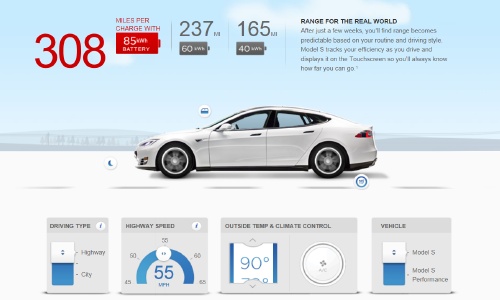
speed=55, temp=90°, tires=19"
|
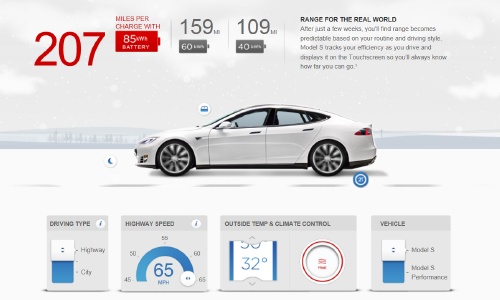
speed=65, temp=32°, heat on, tires=21"
|
Also, note that Tesla's range calculator is based upon very strict assumptions,
which if invalidated, will also negatively affect range even more:
- Constant speed
- Flat ground
- No wind
- 300 lbs of vehicle load (driver+passenger+cargo)
- Sunroof closed
- Tires inflated to recommended pressures
- Battery charged to 100% (not the default 90%)
- NEW battery pack (<1 year, <25,000 miles)
The battery life:
Most everyone with a mobile phone or notebook computer knows, that over
many charging cycles, the effectiveness of a battery decreases.
 10%
10%
|
Tesla even warns:
"The Battery, like all lithium-ion batteries, will
experience gradual energy or power loss with time and use."
What Tesla does not disclose is how many charging cycles results in
a reduction of 10% of the battery. It could be around 25,000 miles.
So the unknown question is, how much potential charge has a particular battery pack lost?
To help extend the life of the Tesla Model S battery pack, the car under normal
charging, will only charge the battery to 90%, at which point, the car will state
"charge complete". The Tesla S can be charged to 100%, but Tesla says that
will reduce the life of the battery pack:
Cold temperatures: Broder was driving when the temperature
was 20° F — And woke up overnight to a 10° F weather. According
to Tesla's website calculator, temperature alone from 90° to 32°
can reduce range in miles by 7.8% at 65 MPH:
| 90° | 70° | 50° | 32° |
| 262 | 255 | 249 | 243 |
speed=65, heat=off, tires=19
| | |
 8%
8%
|
Using the heater: Since Broder was driving in 20°
degree weather, he was using the heater. According to Tesla's website calculator,
that alone can reduce range by 15.3% at 55 MPH.
| 45 | 50 | 55 | 60 | 65 |
| OFF | 339 | 312 | 287 | 264 | 243 |
| ON | 284 | 268 | 249 | 233 | 218 |
temp=32, tires=19
| | |
 15%
15%
|
Tires: According to Tesla's website calculator, using
21" tires instead of 19" tires alone can reduce range by
6.4% at 55 MPH, at 70° F:
| 45 | 50 | 55 | 60 | 65 |
| 19" | 352 | 327 | 301 | 277 | 255 |
| 21" | 329 | 305 | 283 | 260 | 241 |
temp=70, hvac=off
| | |
 6%
6%
|
Driving Speed: According to Tesla's website calculator,
simply driving 65 mph, instead of 55 mph, can reduce range by 18%.
| 45 | 50 | 55 | 60 | 65 |
| 352 | 327 | 301 | 277 | 255 |
temp=70, hvac=off, tires=19
| | |
 18%
18%
|
QUESTION: Given all of the known factors in the New York Times Broder
test drive (speed, temperature, tires, etc), was the range Broder achieved fully
expected, or a "setup" and "fake", as Musk claims?
Q: Was the range Broder obtained in his test drive expected?
If the range Broder obtained was NOT expected, then the article was possibly a "setup".
But, if the range Broder obtained was expected, then the article was NOT a setup.
|
5. Tesla's refusal to provide RAW data
|
|
To definitively answer the tough questions, we need the RAW data that Tesla used to create
the charts displayed in
Elon Musk's blog post:
Why we want the RAW data: To accurately analyze what
actually happened on the Broder test drive, we need to analyze time-based
MPH data in a spreadsheet, instead of the distance-based MPH data that
Tesla provided in chart form. Hopefully the following very simple example
will clearly illustrate what can happen when MPH
data (in distance form) is naively summarized:

What is the average MPH?
| |
| Distance | MPH |
| 10 | 60 |
| 10 | 60 |
| 10 | 60 |
| 10 | 60 |
| 10 | 60 |
| 10 | 60 |
| 10 | 10 |
|
What is the average MPH for the trip shown in chart above (hint: the answer is NOT above 50)?
Show answer
Total trip miles is 70. Total trip time is 2 hours. So the average MPH is 70/2, or 35 MPH.
Asking Tesla for the RAW data:
So on February 20, 2013 at 1:48 PM, I asked Tesla for the RAW data for the MPH graph.
A couple of hours later (at 4:50 PM), I had my answer — Tesla refused to provide
the RAW data. Here is the entire Tesla response I received:
|
"Hi Jerry, Thanks for reaching out. The logs have been released in the rawest form
available and necessary to support the facts. We will not be providing additional
comments or information on this topic as we feel the blog speaks for itself. We
are happy to provide clarity however, should you have any questions. Best,
Tesla Communications"
|
Trust, but verify: Also, we want the RAW data from Tesla to
confirm that Tesla is properly averaging MPH information, and
properly producing accurate charts.
Since Tesla refused to provide the RAW data, and since I am a computer programmer, I just
wrote a quick computer program to extract the RAW data from the charts that Elon Musk
provided. The RAW data files (spreadsheet provide in next section) are provided here for anyone
to download and analyze.
All RAW data is in pixel location form, which must be converted to the units of the chart axis
(MPH, distance, etc) before use:
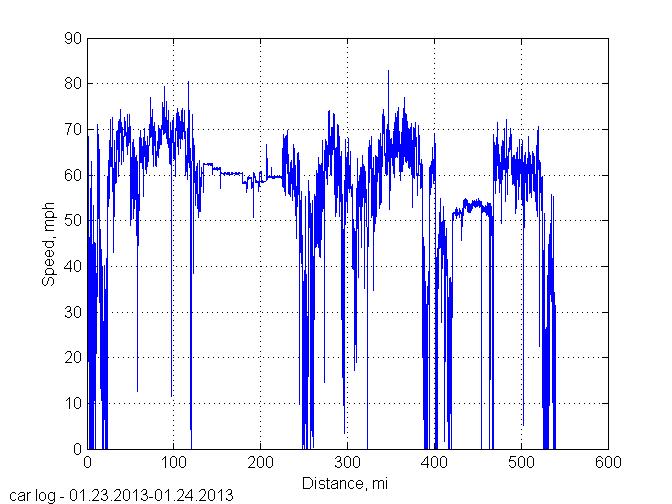
| |
Speed / MPH
raw csv data
Columns: "X, Y-max, Y-min"
X: multiply by 600/521 for distance (in miles)
Y: multiply by 90/411 for speed (in MPH)
|
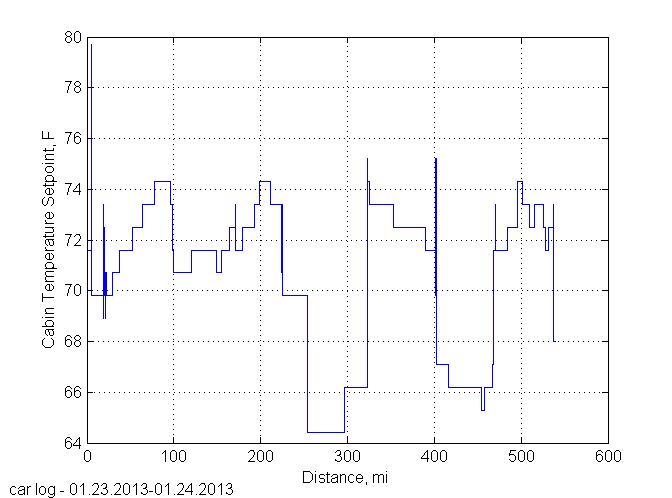
| |
Cabin Temperature
raw csv data
Columns: "X, Y-max, Y-min"
X: multiply by 600/521 for distance (in miles)
Y: multiply by (80-64)/406 and add 64 for temp (in F)
|
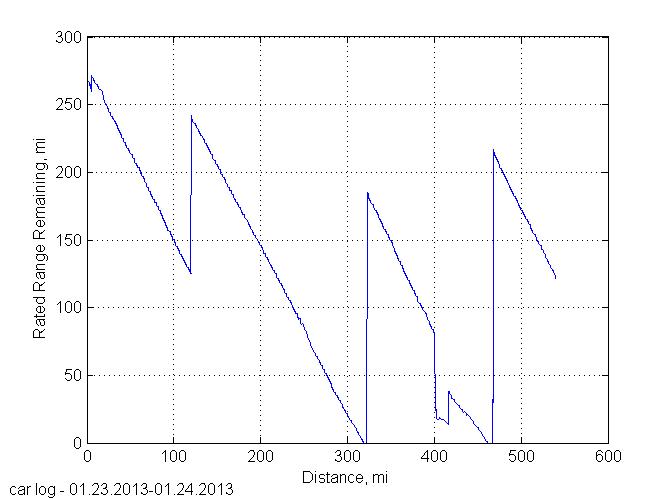
| |
Rated Range Remaining
raw csv data
Columns: "X, Y-max, Y-min"
X: multiply by 600/521 for distance (in miles)
Y: multiply by 300/406 for rated range remaining (in miles)
|
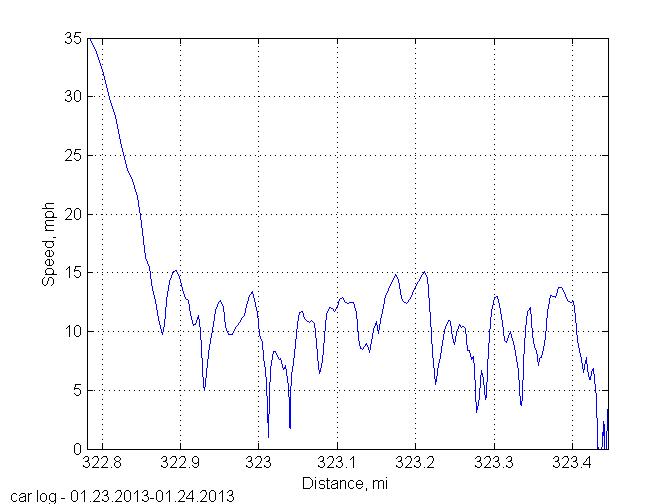
| |
Speed in Milford CT Parking Lot
raw csv data
Columns: "X, Y-max, Y-min"
X: multiply by 0.6/470 for distance (in miles)
Y: multiply by 35/411 for speed (in MPH)
|
To analyze this RAW data, download each CSV file, save to your hard drive,
open in a spreadsheet, and apply the formulas provided (above) to convert
pixels to axis units (spreadsheet provide in next section).
WARNING: This 'RAW data' is the best that we can do without Tesla actually turning over
the real RAW data. As such, please note that every single data item in the spreadsheet has an
inherent 'rounding error', because every data item was rounded to a pixel location on a chart
(by Tesla), which was captured and converted back into a data item (by me).
|
7. The RAW data as a spreadsheet
|
|
|
8. The time-based charts - entire trip
|
|
The charts found in the RAW data spreadsheet mentioned above are reproduced here:
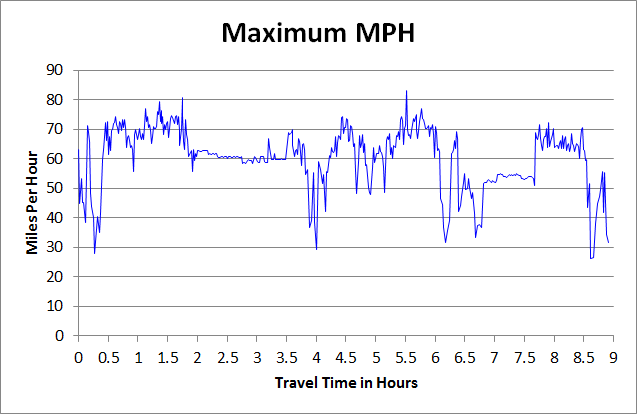
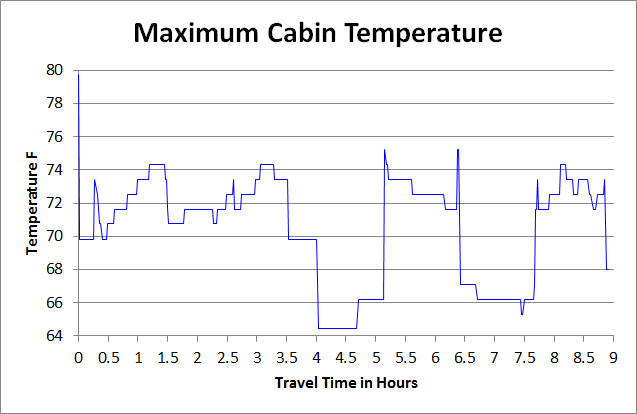
|
9. The trip from Washington, DC to Newark, DE
|
|
Mr. Broder left with a range of 271 miles (on a 100% charge), traveled
115 miles for 1.8 hours at an average speed of 64 MPH. The "mile range"
decreased by 1.26 for every mile driven. The majority of the time,
Broder was driving at 68.5 MPH or faster.
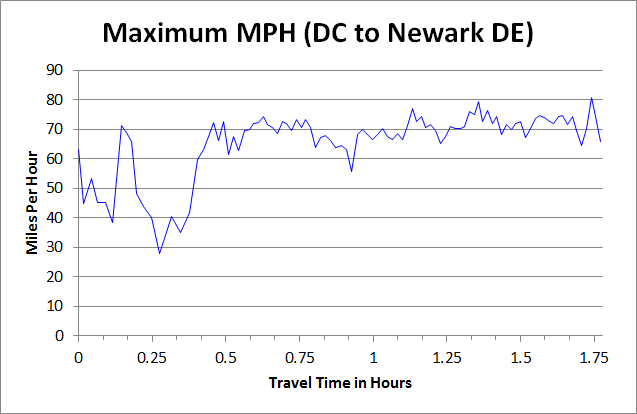
It would be foolish to criticize Mr. Broder for anything he did on a
115 mile trip in a high performance electric car that he was
test driving, with a range of 271 miles.
Given that the car's range was over 2.3x the known travel distance,
the charts actually show that Mr. Broder was actually quite
restrained is his test drive (given that he knew he had lots of
'range to burn').
Would you have been as restrained? If my
brother-in-law were test driving the Model S, you might well
have seen a spike to the maximum speed of the car.
|
10. The trip from Newark, DE to Milford, CT
|
|
Mr. Broder left with a range of 242 miles (from a charge to 90%), traveled
203 miles for 3.4 hours at an average speed of 60 MPH. The "mile range"
decreased by 1.22 for every mile driven. The majority of the time,
Broder was driving at 60.6 MPH or faster.
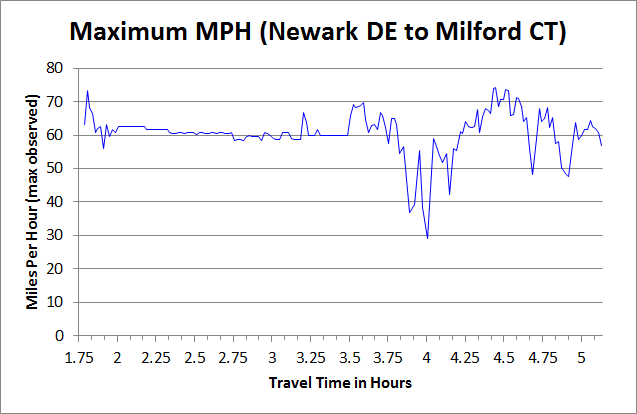
Therefore, plugging in all of the known information into
Tesla's website range calculator
(MPH=60, temp=32, heat=on, tires=19), we get the following expected range answer of 233 miles
BUT for a battery pack charged to 100%:
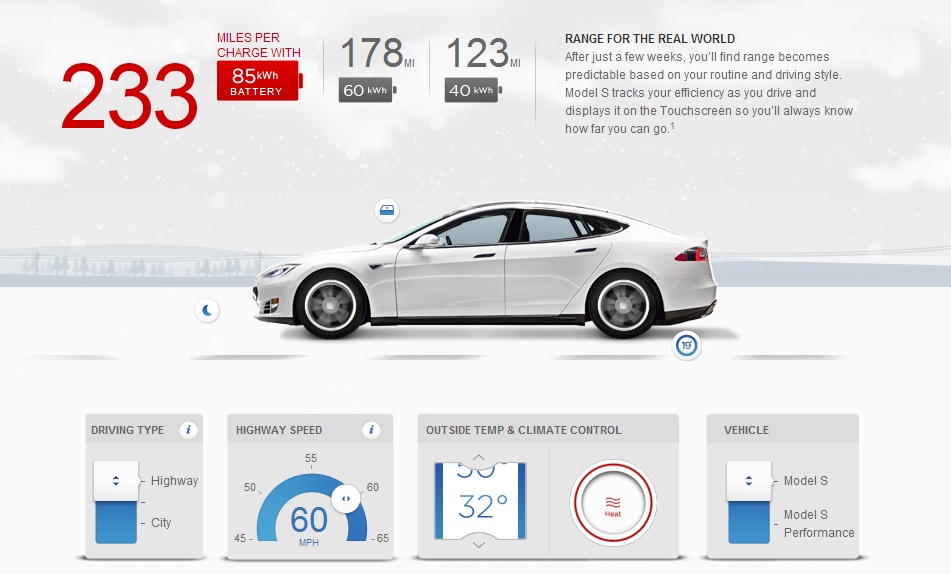
speed=60, temp=32°, heat on, tires=19"
|
So what is the expected range, not for a 100% charge, but for a 90% charge?
Using the known 242 to 271 range difference as a 'model' for the difference between
a 90% charge and a 100% charge, we calculate that a 100% charge at 233 mile
range would, for a 90% charge, provide a 233×242/271, or 208 mile range
(we don't multiply by 90%, as that would not properly account for battery reserve).
The results of this and Tesla's website are summarized here:
| How a 308 mile
range was reduced to 205 miles |
| Factor | Range | Reduction |
| - | 308 | - |
| Temperature: 90° to 32° | 287 | 6.8% |
| Speed: 60 MPH (vs 55) | 264 | 8.0% |
| Heater: on | 233 | 11.7% |
| Charge: 90% (vs 100%) | 208 | 10.7% |
| Temperature: 32° to 19° | 205 | 1.21% |
Therefore, by Tesla's own website range estimates, Broder was only expected
to go 205 miles on a 90% charge under ideal circumstances.
So, Broder was expected (at best) to go 205 miles,
but went 198 miles.
|
How 208 became 198: Temperatures were actually around 19° F
(source), accounting
for a couple miles (2.5) of reduction, but the rest (7.5) likely came from
Broder's "New York City stop", where a slight dip in the battery 'state
of charge' graph can clearly be seen, very likely due a reduction in
temperature of the battery pack while the car was parked.
|
Now, Broder only charged the car to 90%, because that is when his car said
"charge complete" and told him that the range was 242 miles. Elon Musk blames
Broder for 'driving crazy' for not obtaining the 242 mile range, but was
that blame correctly placed? According to the
range chart
that Musk himself provided, Broder was only able to drive 197.7 miles before the "mile range" display
in the car showed 0 (and then the car was driven on 'reserve' power).
|
It is very interesting to note that several Tesla owners tried to prove Broder wrong and
performed the same test drive (but in 15° F warmer weather).
See https://twitter.com/TeslaRoadTrip/.
The postings by meterreader22 are the most interesting. A range of 266.23 miles on a 100%
charge, and with temps in the 30's, then drove 200.4 miles, with a remaining range of 14.1
miles. The fact that 51.73 ((266.23-14.1)-200.4) miles of range
were 'lost' absolutely confirms the negative impact that weather, heater, etc has on range.
And in fact, "mile range" decreased by 1.26 ((266.23-14.1)/200.4)
for every mile driven, confirming the problem with the "mile range" display in the Model S.
That means that the car had a range of 211.61 actual miles, not a range of 266.23 that was
displayed (an overestimate of around 26%).
|
But wait, you exclaim, Broder should have been able to achieve the 242 mile
range. And you would be wrong. Broder's expected range according to
Tesla's own website (due to temperatures, heater, etc) was 205, not 242.
And therein lies the entire problem. Tesla knows the range was 205, but
displayed a range of 242. Incredibly deceptive!
The "mile range" prominently displayed in the Tesla center gauge (see '157'
below; center gauge) is NOT a projected range of the car! Rather, the
"mile range" displayed is based on ideal conditions, invalidated by the cold weather:

Tesla Model S mile range display — showing 157 miles of range (when projected range is only 77)
|
And if you are still confused, just carefully examine
the range chart
provided by Elon Musk
of the Broder test drive, and notice that "Rated Range Remaining" (a record of the "mile range"
displayed by the car), started out at 242, and consistently decreased by 1.22 miles for every 1.0 miles that the
car was driven (see red line in chart below), and then decide for yourself if that is 'smart' or 'dumb':
|
11. Milford, CT until failure
|
|
Mr. Broder charged the car to 72% to a range of 185 miles, for an anticipated 125
(79+46) mile trip. Even with the range being an overestimate, we absolutely know
(from examining the range chart Musk provided; seen right) that the actual mileage
would have been 139 miles, which is enough for the 125 mile trip. Conclusion: If
Broder had NOT stopped overnight, he would have made the trip with no problems,
even in cold weather.
Therefore, Elon Musk's accusation that Broder did not charge to 100%, while
absolutely true, is completely moot. The car would have gone 139 miles,
enough for the 125 mile trip.
But Broder parked his car (after going 79 miles; and the range decreasing 103
miles to 82 miles) for the 46 mile return trip.
The next morning Broder awoke to 10° F weather, and a car that said it
had 25 miles of range left instead of 82 miles (57 mile range lost overnight).
Now, Mr. Broder has received a lot of criticism for not plugging his Tesla Model
S into an outlet overnight, and maybe he should have.
But why is Tesla silent on the issue of the car losing range overnight?
Elon Musk ignores this in his blog.
Tesla deserves to be heavily criticized here, because
Tesla states as a fact on their website,
that:
|
"The Model S battery will not lose a significant amount of charge
when parked for long periods of time. For example, Model S owners can
park at the airport without plugging in."
|
And Tesla's claim ('will not lose charge when parked') may actually be very true
for 70° to 90° F temperatures, but it is not true at 10° F, and
Tesla knows this. Just review the popup warning (seen right) that some
Model S owners receive.
It is 'well known' what will happen to an electric car when the car is
parked in the cold — it will appear to have less energy, which
translates into lost range. Or, the car will use energy, to warm up
the battery to 'restore range', and lose some range in the process.
So, until Tesla changes its website, the blame here falls
squarely on Tesla, for incorrectly claiming that the Modefl S "battery
will not lose a significant amount of charge when parked".

"state of charge" graph shows
Groton to Milford was possible
|
The Shocking Truth:
After conditioning the battery in Groton, CT, if Broder
had ignored the (buggy and incorrect) 19 "mile range" displayed by the
Tesla Model S (and ignored Tesla personnel)
and simply driven back to Milford CT (46 miles), Broder would have
made it, and the graphs provided by Tesla absolutely prove this!
Broder actually printed in his article that Tesla s CTO, JB Straubel,
admitted that some range-related software problems still
needed to be sorted out. Translation: Tesla KNEW that the
"mile range" display had some serious bugs.
So, the range graph, while interesting (it provides a log of 'buggy' numbers
presented to the driver), we need to look elsewhere, like the 'state of charge'
graph.
The proof: Review the 'State of Charge' graph that Tesla provided (seen
right). The all important point is point 2 (Groton in the morning after
'conditioning' the battery).
At that point, as the car was driven to Norwich, CT, but the charge graph shows
that the car would have gone 55 miles (the slope of the decreasing charge
indicates this), enough to make it back the 46 miles to Milford.
And as absolute confirmation, notice that from point 3 — a LOWER state
of charge — the car went 51 miles, which is more than
the 46 mile trip to Milford, CT (from Groton, CT).
Clearly, a range of "19" was wrong: When a range of 19 was displayed by the
Model S, what "state of charge" was that (29.5%)? Find the last time the car was at that
"state of charge" (around mile 267), and then figure out what "mile range"
was displayed then (around 62). Here are these steps graphically from Tesla's charts:

Tesla Model S incorrectly displays "19 mile range" at a 29.5% battery state of charge after battery conditioning
|
Proof from the range chart: If we zoom into the Groton
to Norwich segment in the range chart (seen right), we notice something
rather strange, that at first glance does not make sense:
The "mile range" displayed, starts out at 19 (point 1), and then
goes UP slightly (point 2), before decreasing to 14 (point 3), a total
decrease in range of 5 miles, but over 15 actual miles driven.
The range decreased by 0.33 miles for every mile driven in 10° F weather.
That makes no sense. But interpreting the range graph and the
state of charge graph together, everything makes sense.
In Groton, the battery was in fact
conditioned (state of charge graph says the battery was around 30%),
and ready for the trip back to Milford.
However, the Tesla "mile range" algorithm improperly took into
account part or all of the conditioning time, when the car was using
energy to heat the battery pack, but the car had not moved an inch,
which artificially lowered the "mile range" displayed by the car.
This behavior (after battery conditioning, range is an underestimate) appears
'well known' -- as it easy to find people discussing this on the Internet.
The bottom line: Unless you admit that Tesla's CTO and technical
people can not properly interpret their own charts, you must conclude that
Tesla, and Elon Musk, absolutely knew that the "mile range" displayed to
Broder, after battery conditioning, was wrong, and that Broder could
have made it back to Milford, CT. And rather than saying 'oops, our fault,
our range display has some bugs we are working out and will fix', Elon Musk
decides that the better course of action is to blame the reporter.
|
13. John Broder took bad notes
|
|

John Broder, New York Times
|
John Broder apparently took very inaccurate notes from his test
drive of the Tesla Model S
— under the assumption that the Tesla
charts are an accurate reflection of what actually took place.
Example one: Broder said
"I turned the climate control to low - the temperature was
still in the 30s and planted myself in the far right lane
with the cruise control set at 54 miles per hour (the speed
limit is 65)."
Elon Musk slammed Broder that none of that take place
when Broder said implied took place.
However, Broder did drive around 54 MPH, and with reduced cabin
temperatures, at a different time in the trip. Did Broder
simply confuse two different points in time in his notebook?
Example two:
Broder also said "I limped along at about 45 miles per hour", but
at that time, Broder was going 54 MPH (according to Tesla charts).
Dyslexia anyone, transposed numbers, or something else? Regardless, sloppy.
Something Tesla missed: Broder said
"I drove, slowly, to Stonington, Conn., for dinner and spent
the night in Groton, a total distance of 79 miles. When
I parked the car, its computer said I had 90 miles of range.
... at 8:30 the next morning ... the display showed 25 miles
of remaining range.".
The range after parking was 90, but in Stonington,
not Groton, as the article implies.
After the drive back to Groton, the range displayed was 82.
Very sloppy note taking!
Mr. Broder apparently mixed up numerous points in time, which
normally no one would care about. But given the ultimate outcome
of this test drive (an eletric car needed to be towed), his
inaccuracies has opened up all of his 'story' to be challenged.
But extending that to Broder's "integrity" (as Elon is trying to do)
is something else all together, and not supported by the Tesla
generated graphs.
|
14. Elon Musk overreacted
|
|
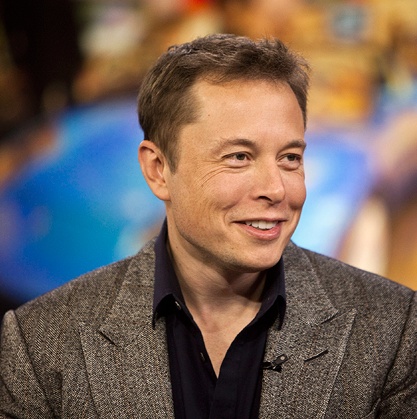
Elon Musk, Tesla
|
Elon came out swinging. On CNBC, Elon accused Broder's article of
being a "setup" for not charging the car to 100%, "driving very fast", and
taking an "extended detour through Manhattan", even going so far as to
call Broder a "fool". And on twitter Elon called the article "fake".
Strong words.
The charts that Elon himself provide show (1) that the average maximum MPH
speed on the troubled 'Newark to Milford' segment was 60 MPH, and (2) that at most,
the detour was just 2 miles. In fact, Tesla's own website shows that Broder
virtually achieved the expected range that he should have achieved.
Tesla expressly warns owners to not charge to 100% because doing so impacts
battery life, but Elon even slams Border for that.
Elon's argument is to attack the inaccurate note-taking, and then, by implication,
apply that to everything Broder says
— and then never address the core issue that Broder discusses: cold
weather affects range, which Tesla's own website range calculator confirms.
Unfortunately, many of Elon Musk's "key facts" in
his blog
are inaccurate, or not the whole truth, which in turn, raises significant
questions about Elon's true motives in this feud:
1) Elon states "Broder in fact drove at speeds from 65 mph to 81 mph for a
majority of the trip".
Not true. The charts that Musk himself provided shows
that for the entire trip, Mr. Broder drove at 65 or greater for a
maximum of 34% of the time. And for the all important Newark, DE
to Milford, CT trip segment, Mr.
Broder drove at 65 or greater a maximum of 18% of the time.
We say 'maximum' because Elon's charts provide a
range of speeds for each mile unit. We assume the worst (the fastest) speed,
and calculate the percentage based upon that. The true percentage will be
lower than this, but can not be calculated until Tesla releases RAW data.
2) Elon harshly criticizes Broder for not charging to 100% every time,
stating "Why would anyone do that?"
Because that is EXACTLY what Tesla's 'road trip' calculator says to do!
For example (on a 400 mile trip at 65 MPH), if the second leg of a trip is 170 miles,
Tesla's website (Road Trips section)
says to Supercharge to only 77% (and in context, that means 197 mile range),
not 100% and not even 90%. Broder did exactly what Tesla's website road trip calculator said
to do!

If that is bad advice, maybe Elon needs to fix the Tesla website, instead of blaming
a reporter! Also, because your car by default says "charge complete" at 90%
charge and because the range displayed by the car was well past the
known travel distance.
Tesla claims "300 miles of range per hour of charge", and Broder charged for
58 minutes, but the Model S only went from -5 miles to 185 miles of range.
3) Elon says that the "Model S battery never ran out of energy".
That is not the whole truth. The Model S, at a
battery "state of charge" of around 4%, shuts down in order to prevent
the charge going to 0%, which would damage the battery and void the battery
warranty. Since the Model S could not be started nor moved, the actual
"state of charge" (0% vs 4%) is a moot point.
So, the next time my daughter comes to me with a 'dead' toy, and
wants the battery replaced/charged, should I get out my multimeter,
detect the weak voltage, and declare to my daughter that the battery never
actually "ran out of energy"?
4) Elon accuses
Broder of driving in circles for five minutes in a unsuccessful
attempt to get the car to die.
Factually wrong. Elon's own charts show that
Broder drove for 0.56 miles for 3.4 minutes at an average speed
of around 9.7 MPH. Where did Elon's 5 minutes come from? Did he just make that
up? If Elon can not properly interpret his own technical charts,
why should anyone believe anything else Elon says about those charts?
Also, that translates to less than four trips around the
tiny parking lot. Broder said he had difficulty finding the charging
station in the dark, which is actually
confirmed by another Model S owner,
and not refuted by the charts.
5) Elon says that Broder had "an average cabin temperature setting of 72° F".
Not true.
The charts show that the average was 70.5° F for the entire trip.
Besides, what a crazy argument in the first place. Is Elon Musk
implying that an average setpoint of 72° F is a problem,
range wise, for the Tesla Model S?
Note that a setpoint of "LO" is 63° F, according to the Model S manual.
6) Elon says "The charge time on his second stop was 47 mins, going from
-5 miles (reserve power) to 209 miles of Ideal or 185 miles of EPA Rated Range, not
58 mins as stated in the graphic attached to his article".
Not true, according to Tesla's own website.
See the entire next section on Supercharger performance
that addresses this issue.
7) Elon slams Broder's "the car fell short of its projected range on the final leg"
statement by exclaiming that the car displayed a range of 32 miles, but actually went 51 miles.
Factually wrong.
The range was 82 miles (it is not 90), not 32 miles. So blatantly telling a partial truth
(range of 32), but not telling the whole truth (that 82 miles of range turned
into 25 miles in range in overnight 10° F cold weather, which turned into
32 miles) is very telling indeed. Elon never addressed the disappearing range
(82 miles to 25 miles) issue. It is far easier to simply ignore the impact
of cold weather, than to address it head on.
Besides, the Model S does not have 19 (51-32) miles of reserve power. As the
range remaining graph clearly shows, once range hits 0 miles, the car only went
about 6 miles. Meaning that the other 13 miles were because the range display
was once again, buggy!
Elon Musk should have been interested in finding out the truth (why the
"mile range" in the Model S, which a reporter trusted, was so inaccurate),
but instead Mr. Musk decided to sling some mud by slamming minor factual
inaccuracies in Mr. Broder's article, in an attempt to characterize the
entire article (range is reduced in the cold) as "fake' — by
stating numerous factual inaccuracies himself.
That is not 'CEO level' behavior.
|
15. Tesla Supercharger Performance
|
|
According to Tesla provided charts, Broder's second charge increased the battery
"state of charge" from 4% to 72% (68% difference). Broder said that took 58
minutes. That seems reasonable given the extreme cold, and that Tesla's own
website (seen right) says it takes 55 minutes to charge from 10% to 77%
(67% difference).
But Elon slamed Broder, stating "The charge time on his second stop was
47 mins ... not 58 mins as stated in the graphic attached to his article.
Had Broder not deliberately turned off the Supercharger at 47 mins and
actually spent 58 mins Supercharging, it would have been virtually
impossible to run out of energy for the remainder of his stated journey."
If Elon is right, then Tesla's own website stating charging times, is wrong.
At first glance, Elon's claim would seem impossible to confirm or refute.
But what we do have is
Tesla's own website
(Road Trips Section) telling us how long it takes (in minutes) to increase
the charge of a 85 kWh battery from 10% to various levels. The website
data points were collected into the RAW data spreadsheet and
charted (blue line):
The results are surprising. And to assist in seeing the results, the chart
time in minutes has been zeroed to a 4% charge.
Tesla's own data in this chart predicts that charging from 4% to
72% translates into 54.5 minutes charge time. And, given the
extreme cold, some of the charge would be used to keep the battery
warm, which would increase the charge time slightly.
After a little research on Google, the non-linear charge rate on the Model S
is called "charge tapering". See
Inside Scoop on Tesla s Super-Smart Supercharger Network,
Hands-On With Tesla's Supercharger,
and this
Tesla forum entry
claiming that a Tesla engineer stated that Supercharging charges at a high
rate to 50%, then tapers off a little until 80%, and then tapers off even more.
Given (a) known charge tapering, (b) the extreme cold temperatures,
and (c) Tesla's own website data, Broder's charge time of 58 minutes (blue
circle) seems much more accurate than Elon's claim of 47 minutes
(red circle).
What does seem clear, is that Elon's statement of 47 minutes
lines up directly (dashed red line) with Tesla's 'ideal model'
that it takes exactly 60 minutes to charge from 4% to 90%
and that there is NO charge tapering.
Namely, someone at Tesla said that a charge from 4% to 90% takes 60
minutes, therefore a charge from 4% to 72% should take
(72-4)/(90-4)*60, or 47 minutes — which does not
take into account known charge tapering!
The web has reports of Supercharger charging that indicate clear charge tapering.
Here are a few:
- 01/29/2013: Consumer Reports
- 45 min: 160 to 242 miles (to 90% SOC)
— Milford CT.
- 02/19/2013: CNBC
- 60 min: 155 to 265 miles (to 100% SOC)
— Newark, DE.
- 02/25/2013: CNN test drive
- 90 min: 38 to 270 miles (to 100% SOC)
— Milford, CT.
- 11/28/2012: Tesla Motors forum post
- 75 min: 56 to 240 miles (to 90% SOC)
But the web also has this report of faster than normal charging (but before
the Supercharger stations officially opened Oct 19), that just happens to match the
slope of the 'no tapering' charging rate:
- 10/01/2012: plugincars.com
- 40 min: 8 to 163 miles (8.8% to 64.3% SOC)
So, it appears That Tesla implemented more agressive tapering after initial testing.
Clearly, the full story on this issue has not yet been written.
|
This entire analysis could all be wrong, but then Tesla's website
giving charge times is also wrong. Or, Elon is wrong. Or did Tesla change firmware
and adjust charge tapering? Tesla needs to disclose a LOT more information before
we can become comfortable with all of these discrepancies.
|
16. How to get a Tesla to fail to go 200 miles
|
|
Headwind: The Tesla web site
says
that driving into a headwind is virtually identical
to driving a car 'that much faster' with no wind.
So, driving 60 MPH steady, but into a 15 MPH headwind, is exactly (range wise)
like driving steady at 75 MPH with no wind.
If so, a Tesla,
100% charged,
in 30° F weather,
using the heater,
going 60 MPH steady on cruise control,
with 21" tires,
but with a 15 MPH headwind, would likely not make it 200 miles, even with reserve power.
We know the range (at 100% charge) at 60 MPH under these conditions is 221 miles
and at 65 MPH is 207. Apply the same rate to get to 75 MPH and you get 181.6 miles
and there would likely not be over 18 miles of reserve power.
Cold Weather: And if you don't believe that cold weather can have a negative impact
on the Model S, just read a February 15, 2013 Consumer Reports news article titled
Winter chills limit range of the Tesla Model S electric car
that concluded:
"To its credit, the Model S delivered 176 miles from a full charge in cold
weather--considerably more than any other EV on the planet. While it was in
line with what the car predicted, it proved well short of the rated 240 miles
the car promised when I started, let alone the 265 estimated by the EPA or
the 300 touted by Tesla.
...
Any potential EV buyers in the Snow Belt should consider our experience; winter
exacts a tough toll on range."
|
|
17. Conclusion / Lessons Learned
|
|
John Broder took inaccurate notes. But that does not alter the fact
of how the car performed in very cold weather. It lost range. The
car performed exactly how the range calculator on the Tesla website
said it would perform, given all of the conditions Broder ran into.
Therefore, we can see the significant factor that cold weather had
on this test. Elon Musk improperly blamed Broder for obtaining a
range fully predicted by the Tesla website range calculator.
The real person to blame here is the idiot at Tesla that designed
the "range" displayed in the car (seen right) that ignores outside
temperatures. Foolish and stupid! This is what the Model S owners guide says:
"To change how range, touch CONTROLS > SETTINGS > UNITS & FORMAT.
You can display Ideal or Rated range. Ideal is based on driving
a steady 55 mph on a flat road whereas Rated is based on metrics
determined as a result of EPA testing."
— Model S Owners Guide
|
Has Tesla learned a lesson from the Broder test drive? -- That prominently
displaying a "mile range" that does not account for temperature and HVAC usage
is incredibly deceiving?
|
This "mile range" problem (based upon EPA driving conditions instead of actual driving conditions)
is a very well known problem with the Tesla.
Even Consumer Reports felt the need to point this out in a report titled
Winter chills limit range of the Tesla Model S electric car
stating: Perhaps it's the "projected range" that needs to display more prominently than the "rated range."
|
Just consider this: What if Mr. Broder, knowing he had to travel 202 miles,
after charging to "charge complete" (90%) at Milford, would have seen an
more accurate range remaining of 205 miles, instead of the inaccurate
range remaining of 242 that he relied upon? Mr. Broder certainly would have
figured out for himself that he needed to extend the range, either by
charging past 90% (or by driving slower or with no heat).
If Mr. Broder had conducted this test drive in the summer, it would have been
a resounding success — based upon Tesla's range calculator.
Temperature matters when you have an electric car.
Elon Musk - are you listening? Fix the range display in the Tesla Model S.
|
Another Lesson Learned:
Where is the 'fuel guage' that represents the 'state of charge' of the car?
Is it the slider above the range display? Or is that slider a representation
of current range to max range? If you can't tell, then what good is the
display? If Broder and Tesla could not immediately figure out that a range
of 19 was strange, given the 'state of charge' of 30%, that is an indication
of a badly designed user interface. There is absolutely no doubt that the
Tesla gauge interface looks very nice, but if the driver (AND Tesla support
personnel) could not understand that the car had a 30% charge when a 19 mile
range was displayed, then something is wrong with the user interface.
|
Both sides in this feud are to blame for poor judgment. Musk and Broder
should meet in person and talk through this. It is too easy to (inappropriately)
slam someone when you are not looking into their eyes.
1)
Tesla claims
"300 miles of range per hour of charge" for the Supercharger.
Why after 80 minutes of charging did Mr. Broder only get a range of 216
miles (approx. 81% charge)?
Any reporter testing the Supercharger network
needs to test with with a car with zero miles of range, and time how long
it takes to charge to 50%, 80%, 90%, and then 100%.
Test in both warm and freezing temperatures.
The Supercharger section has been added to
address some of these issues, but a Google search shows that Model S
owners get wildly different charge times. Is this because Tesla is
constantly refining their firmware, or are there other reasons? Something
for some reporter to research.
2) If the only way to reliably go 200 miles is to charge the
battery pack in the car to 100%, which Tesla says will "reduce the lifetime"
of the battery pack, Tesla needs to disclose exactly what that means.
Will the battery have 50% less life, 10% less life, 1% less life?
A battery graph from Panasonic suggests charging to a lower voltage
(less capacity) can extend the life of a battery by 50%, meaning the always
charging to 100% would reduce the life of a battery by 33%.
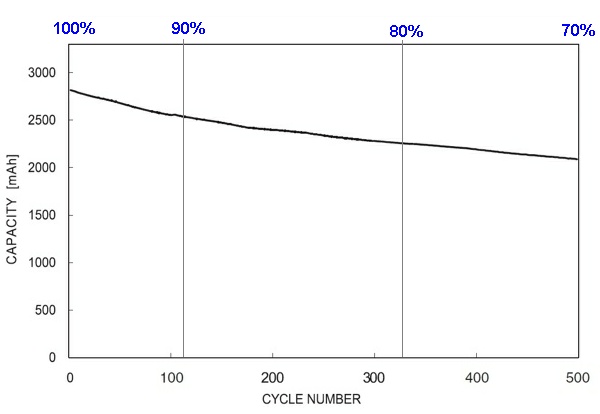
NCR-18650 Battery Typical Life Characteristics
|
3)
Tesla's range calculator is only valid for cars with a
"New battery pack (<1 year, <25,000 miles)". What
happens after that?
How many charge cycles (miles) until the battery pack
is at 90% capacity? Tesla even says "The Battery, like all
lithium-ion batteries, will experience gradual energy or
power loss with time and use."
A critical question to answer, because then, even at a 100% charge, a Model S
with a battery at 90% capacity would have great difficulty reliably going 200
miles in the cold!
It is widely reported that Tesla uses
"more than 7,000 Panasonic nickel-cathode lithium-ion 18650"
batteries.
Review a
data sheet
for a similar cell, and research information for a
long life cell.
If Tesla's cells behave like the 'long life cell' above, that would
mean a 4% reduction in battery capacity after 58,000 miles. But if
Tesla's cells behave like the normal 16850 cell, that would mean a 10%
reduction in battery capacity after just 25,000 miles.
even more info
Until Tesla discloses more information about lifetime (cycles of charge) and
capacity (degradation chart) for its battery pack, it is impossible to know.
4) Tesla states "Compared to a vehicle like the BMW 535i, Model S will
save its owners approximately $8,000 over five years in fuel costs alone",
which is $12,800 prorated to 8 years. It costs $12,000 to purchase
the battery replacement option from Tesla (85 kWh battery replaced in 8 years) up-front
for the Model S. So, if the replacement option is purchased up-front, where are
the savings?

Roadster pushed into Top Gear garage
|
5) Is Elon too sensitive? Top Gear said "Although Tesla say it will
do 200 miles, we worked out that on our track that it would run out after just
55 miles."
To underscore the point of reduced range, Top Gear showed what would
have happened, a Roadster being pushed into the Top Gear garage
(note
this Tesla chart showing
reduced range by driving fast).
Tesla sued for "defamation and malicious falsehood"
because Top Gear never actually drove the car until it died on
the track (only showing that it would have died prior to 200 miles under test track conditions).
Tesla lost in court.
Watch the
Top Gear Episode
and
Elon's response
and decide for yourself.
6) How is Tesla going to handle queuing at Supercharger stations? As long
as no-one has a Model S, drive right up and use the Supercharger. But as
the Model S becomes popular, and multiple people want to Supercharge at the
same time, queue up, and wait?
|
|